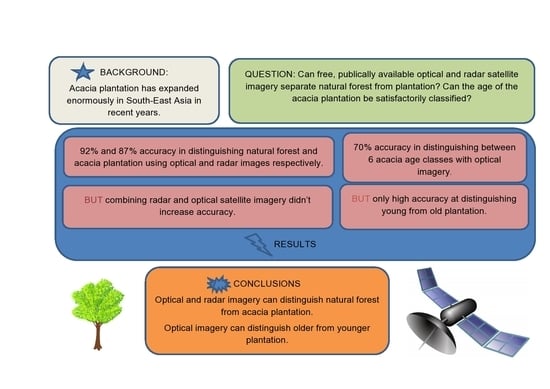Synergistic Use of Sentinel-1 and Sentinel-2 to Map Natural Forest and Acacia Plantation and Stand Ages in North-Central Vietnam
Abstract
1. Introduction
- What is the classification accuracy of Sentinel-1 (SAR), Sentinel-2 (optical) and S-1 and S-2 combined for distinguishing natural forest and acacia plantation?
- Can acacia plantation age be accurately classified?
2. Materials and Methods
2.1. Study Site
2.2. Data Sources
2.2.1. Sentinel-1 Data
2.2.2. Sentinel-2 Data
2.2.3. Ancillary Data
2.3. Methodology
2.3.1. Time-Series
2.3.2. Sentinel-1 Processing
2.3.3. S-2 Processing
2.3.4. Random Forest
2.3.5. Plantation Age
3. Results
3.1. Time-Series
3.1.1. Time-Series–Sentinel-1
3.1.2. Time-Series—Sentinel-2
3.2. Natural Forest and Plantation Classification Accuracy
3.2.1. Natural Forest and Plantation Classification Accuracy: Sentinel-1
3.2.2. Random Forest: Sentinel-2
3.3. Plantation Age
4. Discussion
4.1. Plantation and Natural Forest Classification
4.2. Plantation Age Classification
5. Conclusions
Author Contributions
Funding
Institutional Review Board Statement
Informed Consent Statement
Data Availability Statement
Conflicts of Interest
References
- Keenan, R.J.; Reams, G.A.; Achard, F.; de Freitas, J.V.; Grainger, A.; Lindquist, E. Dynamics of global forest area: Results from the FAO Global Forest Resources Assessment 2015. For. Ecol. Manag. 2015, 352, 9–20. [Google Scholar] [CrossRef]
- Meyfroidt, P.; Lambin, E.F. Forest transition in vietnam and displacement of deforestation abroad. Proc. Natl. Acad. Sci. USA 2009, 106, 16139–16144. [Google Scholar] [CrossRef] [PubMed]
- Hansen, M.C.; Potapov, P.V.; Moore, R.; Hancher, M.; Turubanova, S.A.; Tyukavina, A.; Thau, D.; Stehman, S.V.; Goetz, S.J.; Loveland, T.R.; et al. High-Resolution global maps of 21st-century forest cover change. Science 2013, 342, 850–853. [Google Scholar] [PubMed]
- Lewis, S.L.; Wheeler, C.E.; Mitchard, E.T.; Koch, A. Restoring Natural Forests is the Best Way to Remove Atmospheric Carbon. Nature 2019, 568, 25–28. [Google Scholar] [CrossRef]
- Horák, J.; Brestovanská, T.; Mladenović, S.; Kout, J.; Bogusch, P.; Halda, J.P.; Zasadil, P. Green Desert? Biodiversity patterns in forest plantations. For. Ecol. Manag. 2019, 433, 343–348. [Google Scholar] [CrossRef]
- Phillips, H.R.; Newbold, T.; Purvis, A. Land-Use effects on local biodiversity in tropical forests vary between continents. Biodivers. Conserv. 2017, 26, 2251–2270. [Google Scholar] [CrossRef]
- Barlow, J.; Gardner, T.A.; Araujo, I.S.; Ávila-Pires, T.C.; Bonaldo, A.B.; Costa, J.E.; Esposito, M.C.; Ferreira, L.V.; Hawes, J.; Hernandez, M.I. Quantifying the biodiversity value of tropical primary, secondary, and plantation forests. Proc. Natl. Acad. Sci. USA 2007, 104, 18555–18560. [Google Scholar]
- Ngo, D.T.; Van Le, A.; Le, H.T.; Stas, S.; Le, T.; Tran, H.; Pham, T.; Le, T.; Spracklen, B.; Langan, C. The potential for REDD+ to reduce forest degradation in vietnam. Environ. Res. Lett. 2020, 15, 07402. [Google Scholar] [CrossRef]
- Meyfroidt, P.; Lambin, E.F. Forest transition in vietnam and its environmental impacts. Glob. Chang. Biol. 2008, 14, 1319–1336. [Google Scholar] [CrossRef]
- Nambiar, E.S.; Harwood, C.E.; Kien, N.D. Acacia plantations in vietnam: Research and knowledge application to secure a sustainable future. South. For. A J. For. Sci. 2015, 77, 1–10. [Google Scholar]
- Spracklen, B.D.; Spracklen, D.V. Old-Growth forest disturbance in the ukrainian carpathians. Forests 2020, 11, 151. [Google Scholar] [CrossRef]
- Omar, H.; Misman, M.A.; Kassim, A.R. Synergetic of PALSAR-2 and Sentinel-1A SAR polarimetry for retrieving aboveground biomass in dipterocarp forest of Malaysia. Appl. Sci. 2017, 7, 675. [Google Scholar] [CrossRef]
- Huang, X.; Ziniti, B.; Torbick, N.; Ducey, M.J. Assessment of Forest above Ground Biomass Estimation Using Multi-Temporal C-Band Sentinel-1 and Polarimetric L-Band PALSAR-2 Data. Remote Sens. 2018, 10, 1424. [Google Scholar] [CrossRef]
- Li, Z.; Fox, J.M. Rubber tree distribution mapping in Northeast Thailand. Int. J. Geosci. 2011, 2, 573. [Google Scholar] [CrossRef]
- Zhai, D.; Dong, J.; Cadisch, G.; Wang, M.; Kou, W.; Xu, J.; Xiao, X.; Abbas, S. Comparison of Pixel-and Object-Based approaches in phenology-based rubber plantation mapping in Fragmented Landscapes. Remote Sens. 2018, 10, 44. [Google Scholar] [CrossRef]
- Lazecky, M.; Lhota, S.; Penaz, T.; Klushina, D. Application of sentinel-1 satellite to identify oil palm plantations in balikpapan bay. In IOP Conference Series: Earth and Environmental Science; IOP Publishing: Bristol, UK, 2018; Volume 169, p. 012064. [Google Scholar]
- Miettinen, J.; Liew, S.C.; Kwoh, L.K. Usability of Sentinel-1 Dual Polarization C-Band Data for Plantation Detection in Insular Southeast Asia. In Proceedings of the 36th Asian Conference on Remote Sensing (ACRS2015), Quezon City, Philippines, 19–23 October 2015; Citeseer: Princeton, NJ, USA, 2015; pp. 19–23. [Google Scholar]
- Dong, X.; Quegan, S.; Uryu, Y.; Zeng, T. Classifying Indonesian Plantation and Natural Forest Cover and Measuring Changes with C-and L-Band SAR Data. In Proceedings of the ESA’s Living Planet Symposium, Edinburgh, UK, 9–13 September 2013. [Google Scholar]
- Carolita, I.; Darmawan, S.; Permana, R.; Dirgahayu, D.; Wiratmoko, D.; Kartika, T.; Arifin, S. Comparison of Optic Landsat-8 and SAR Sentinel-1 in Oil Palm Monitoring, Case Study: Asahan, North Sumatera, Indonesia. In IOP Conference Series: Earth and Environmental Science; IOP Publishing: Bristol, UK, 2019; Volume 280, p. 012015. [Google Scholar]
- Poortinga, A.; Tenneson, K.; Shapiro, A.; Nquyen, Q.; San Aung, K.; Chishtie, F.; Saah, D. Mapping Plantations in Myanmar by Fusing Landsat-8, Sentinel-2 and Sentinel-1 Data along with Systematic Error Quantification. Remote Sens. 2019, 11, 831. [Google Scholar]
- Dong, J.; Xiao, X.; Chen, B.; Torbick, N.; Jin, C.; Zhang, G.; Biradar, C. Mapping Deciduous Rubber Plantations through Integration of PALSAR and Multi-Temporal Landsat Imagery. Remote Sens. Environ. 2013, 134, 392–402. [Google Scholar] [CrossRef]
- Kou, W.; Xiao, X.; Dong, J.; Gan, S.; Zhai, D.; Zhang, G.; Qin, Y.; Li, L. Mapping deciduous rubber plantation areas and stand ages with PALSAR and landsat images. Remote Sens. 2015, 7, 1048–1073. [Google Scholar]
- Hoang, T.T.; Truong, V.T.; Hayashi, M.; Tadono, T.; Nasahara, K.N. New JAXA High-Resolution Land Use/Land cover map for vietnam aiming for natural forest and plantation forest monitoring. Remote Sens. 2020, 12, 2707. [Google Scholar]
- Huong, V.D.; Nambiar, E.K.; Hai, N.X.; Ha, K.M.; Dang, N.V. Sustainable management of acacia auriculiformis plantations for wood production over four successive rotations in South Vietnam. Forests 2020, 11, 550. [Google Scholar] [CrossRef]
- Ministry of Agriculture and Rural development (MARD). Approval of a Wood Production Management Plan for the Period 2014–2020; Ministry of Agriculture and Rural development (MARD): Hanoi, Vietnam, 2014.
- Dewar, R.C.; Cannell, M.G. Carbon Sequestration in the Trees, Products and Soils of Forest Plantations: An Analysis Using UK Examples. Tree Physiol. 1992, 11, 49–71. [Google Scholar] [CrossRef] [PubMed]
- Lugo, A.E. Comparison of tropical tree plantations with secondary forests of similar age: Ecological archives M062-001. Ecol. Monogr. 1992, 62, 1–41. [Google Scholar] [CrossRef]
- Sheldon, F.H.; Styring, A.; Hosner, P.A. Bird species richness in a bornean exotic tree plantation: A long-term perspective. Biol. Conserv. 2010, 143, 399–407. [Google Scholar] [CrossRef]
- Styring, A.R.; Ragai, R.; Unggang, J.; Stuebing, R.; Hosner, P.A.; Sheldon, F.H. Bird community assembly in bornean industrial tree plantations: Effects of forest age and structure. For. Ecol. Manag. 2011, 261, 531–544. [Google Scholar]
- Lung, N.N.; Quat, N.X.; Lien, A.P.D.T.V.; Que, A.P.D.N.D.; Van Con, A.P.D.T.; Ky, A.P.D.N.D.; Cam, L.V. Final Report on Forest Ecological Stratification in Vietnam; UN-REDD Program Vietnam: Hanoi, Vietnam, 2011. [Google Scholar]
- Ngo-Duc, T. Climate change in the coastal regions of Vietnam. In Coastal Disasters and Climate Change in Vietnam; Elsevier: Amsterdam, The Netherlands, 2014; pp. 175–198. [Google Scholar]
- Mahood, S.; Van Trần, H. The Biodiversity of Bac Huong Hoa Nature Reserve, Quang Tri Province, Vietnam; BirdLife International Vietnam Programme: Hanoi, Vietnam, 2008. [Google Scholar]
- Louis, J.; Debaecker, V.; Pflug, B.; Main-Knorn, M.; Bieniarz, J.; Mueller-Wilm, U.; Cadau, E.; Gascon, F. Sentinel-2 Sen2Cor: L2A Processor for Users. In Living Planet Symposium 2016; Spacebooks Online: Prague, Czech Republic, 2016; pp. 1–8. [Google Scholar]
- Rodriguez-Galiano, V.F.; Ghimire, B.; Rogan, J.; Chica-Olmo, M.; Rigol-Sanchez, J.P. An Assessment of the Effectiveness of a Random Forest Classifier for Land-Cover Classification. ISPRS J. Photogramm. Remote Sens. 2012, 67, 93–104. [Google Scholar] [CrossRef]
- Zimmermann, N.E.; Edwards, T.C.; Moisen, G.G.; Frescino, T.S.; Blackard, J.A. Remote sensing-based predictors improve distribution models of rare, early successional and broadleaf tree species in Utah. J. Appl. Ecol. 2007, 44, 1057–1067. [Google Scholar]
- Spracklen, B.D.; Spracklen, D.V. Identifying european old-growth forests using remote sensing: A study in the Ukrainian Carpathians. Forests 2019, 10, 127. [Google Scholar]
- QGIS. QGIS Geographic Information System; QGIS Association: Fribourg, Switzerland, 2021. [Google Scholar]
- Haralick, R.M. Statistical and structural approaches to texture. Proc. IEEE 1979, 67, 786–804. [Google Scholar]
- Coburn, C.A.; Roberts, A.C. A multiscale texture analysis procedure for improved forest stand classification. Int. J. Remote Sens. 2004, 25, 4287–4308. [Google Scholar] [CrossRef]
- Wang, H.; Zhao, Y.; Pu, R.; Zhang, Z. Mapping robinia pseudoacacia forest health conditions by using combined spectral, spatial, and textural information extracted from ikonos imagery and random forest classifier. Remote Sens. 2015, 7, 9020–9044. [Google Scholar]
- Rodriguez-Galiano, V.F.; Chica-Olmo, M.; Abarca-Hernandez, F.; Atkinson, P.M.; Jeganathan, C. Random forest classification of mediterranean land cover using multi-seasonal imagery and multi-seasonal texture. Remote Sens. Environ. 2012, 121, 93–107. [Google Scholar] [CrossRef]
- SNAP. ESA Sentinel Application Platform V6; European Space Agency (ESA): Paris, France, 2021. [Google Scholar]
- De Alban, J.D.T.; Connette, G.M.; Oswald, P.; Webb, E.L. Combined landsat and l-band sar data improves land cover classification and change detection in dynamic tropical landscapes. Remote Sens. 2018, 10, 306. [Google Scholar] [CrossRef]
- Sarzynski, T.; Giam, X.; Carrasco, L.; Lee, J.S.H. Combining radar and optical imagery to map oil palm plantations in Sumatra, Indonesia, using the google earth engine. Remote Sens. 2020, 12, 1220. [Google Scholar]
- Nasirzadehdizaji, R.; Balik Sanli, F.; Abdikan, S.; Cakir, Z.; Sekertekin, A.; Ustuner, M. Sensitivity analysis of multi-temporal sentinel-1 sar parameters to crop height and canopy coverage. Appl. Sci. 2019, 9, 655. [Google Scholar]
- Tonolli, S.; Dalponte, M.; Neteler, M.; Rodeghiero, M.; Vescovo, L.; Gianelle, D. Fusion of airborne LiDAR and satellite Multispectral data for the estimation of Timber Volume in the Southern Alps. Remote Sens. Environ. 2011, 115, 2486–2498. [Google Scholar] [CrossRef]
- Breiman, L. Random forests. Mach. Learn. 2001, 45, 5–32. [Google Scholar] [CrossRef]
- Immitzer, M.; Atzberger, C.; Koukal, T. Tree species classification with random forest using very high spatial resolution 8-band Worldview-2 Satellite data. Remote Sens. 2012, 4, 2661–2693. [Google Scholar]
- Nelson, M. Evaluating Multitemporal Sentinel-2 Data for Forest Mapping Using Random Forest; Stockholm University: Stockholm, Switzerland, 2017. [Google Scholar]
- Puletti, N.; Chianucci, F.; Castaldi, C. Use of Sentinel-2 for forest classification in mediterranean environments. Ann. Silvic. Res. 2017. [Google Scholar]
- Sheeren, D.; Fauvel, M.; Josipović, V.; Lopes, M.; Planque, C.; Willm, J.; Dejoux, J.-F. Tree species classification in temperate forests using formosat-2 satellite image time series. Remote Sens. 2016, 8, 734. [Google Scholar]
- Thanh Noi, P.; Kappas, M. Comparison of random forest, k-Nearest neighbor, and support vector machine classifiers for land cover classification using Sentinel-2 imagery. Sensors 2018, 18, 18. [Google Scholar]
- Abdi, A.M. Land cover and land use classification performance of machine learning algorithms in a boreal landscape using Sentinel-2 data. Giscience Remote Sens. 2020, 57, 1–20. [Google Scholar] [CrossRef]
- Mansaray, L.R.; Wang, F.; Huang, J.; Yang, L.; Kanu, A.S. Accuracies of support vector machine and random forest in rice mapping with Sentinel-1a, Landsat-8 and Sentinel-2a datasets. Geocarto Int. 2020, 35, 1088–1108. [Google Scholar] [CrossRef]
- Adam, E.; Mutanga, O.; Odindi, J.; Abdel-Rahman, E.M. Land-Use/Cover classification in a heterogeneous coastal landscape using rapideye imagery: Evaluating the performance of random forest and support vector machines classifiers. Int. J. Remote Sens. 2014, 35, 3440–3458. [Google Scholar] [CrossRef]
- Foody, G.M.; Mathur, A. A Relative evaluation of multiclass image classification by support vector machines. IEEE Trans. Geosci. Remote Sens. 2004, 42, 1335–1343. [Google Scholar] [CrossRef]
- Krizhevsky, A.; Sutskever, I.; Hinton, G.E. Imagenet classification with deep convolutional neural networks. Commun. ACM 2017, 60, 84–90. [Google Scholar]
- Pedregosa, F.; Varoquaux, G.; Gramfort, A.; Michel, V.; Thirion, B.; Grisel, O.; Blondel, M.; Prettenhofer, P.; Weiss, R.; Dubourg, V. Scikit-Learn: Machine learning in Python. J. Mach. Learn. Res. 2011, 12, 2825–2830. [Google Scholar]
- Adelabu, S.; Mutanga, O.; Adam, E. Testing the reliability and stability of the internal accuracy assessment of random forest for classifying tree defoliation levels using different validation methods. Geocarto Int. 2015, 30, 810–821. [Google Scholar] [CrossRef]
- Lachin, J.M. Introduction to sample size determination and power analysis for clinical trials. Control. Clin. Trials 1981, 2, 93–113. [Google Scholar]
- Dietterich, T.G. Approximate statistical tests for comparing supervised classification learning Algorithms. Neural Comput. 1998, 10, 1895–1923. [Google Scholar]
- White, J.C.; Saarinen, N.; Wulder, M.A.; Kankare, V.; Hermosilla, T.; Coops, N.C.; Holopainen, M.; Hyyppä, J.; Vastaranta, M. Assessing spectral measures of post-harvest forest recovery with field plot data. Int. J. Appl. Earth Obs. Geoinf. 2019, 80, 102–114. [Google Scholar]
- Haywood, A.; Verbesselt, J.; Baker, P.J. Mapping disturbance dynamics in wet sclerophyll forests using time series landsat. Int. Arch. Photogramm. Remote Sens. Spat. Inf. Sci. 2016, 41, 633–639. [Google Scholar]
- Attarchi, S.; Gloaguen, R. Classifying Complex Mountainous Forests with L-Band SAR and Landsat Data Integration: A Comparison among Different Machine Learning Methods in the Hyrcanian Forest. Remote Sens. 2014, 6, 3624–3647. [Google Scholar] [CrossRef]
- Sein, C.C.; Mitlöhner, R. Acacia Hybrid: Ecology and Silviculture in Vietnam; CIFOR: Bogor, Indonesia, 2011. [Google Scholar]
- Miettinen, J.; Hooijer, A.; Shi, C.; Tollenaar, D.; Vernimmen, R.; Liew, S.C.; Malins, C.; Page, S.E. Extent of Industrial Plantations on S Outheast A Sian Peatlands in 2010 with Analysis of Historical Expansion and Future Projections. GCB Bioenergy 2012, 4, 908–918. [Google Scholar] [CrossRef]
- Anuar, A.N.; Jusoh, I.; Suhaili, A.; Munir, M.B. Mapping vegetation cover of acacia mangium plantation by age. Trans. Sci. Technol. 2017, 4, 482–488. [Google Scholar]
- Li, Z.; Fox, J.M. Mapping rubber tree growth in mainland southeast asia using time-series MODIS 250 m NDVI and statistical data. Appl. Geogr. 2012, 32, 420–432. [Google Scholar]
- Maraseni, T.N.; Son, H.L.; Cockfield, G.; Duy, H.V.; Dai Nghia, T. Comparing the financial returns from acacia plantations with different plantation densities and rotation ages in vietnam. For. Policy Econ. 2017, 83, 80–87. [Google Scholar]
- Stas, S.M.; Le, T.C.; Tran, H.D.; Hoang, T.T.H.; van Kuijk, M.; Van Le, A.; Ngo, D.T.; van Oostrum, A.; Phillips, O.L.; Rutishauser, E. Logging intensity drives variability in carbon stocks in lowland forests in vietnam. For. Ecol. Manag. 2020, 460, 117863. [Google Scholar]
- Zhunusova, E.; Sen, L.T.H.; Schröder, J.-M.; Ziegler, S.; Dieter, M.; Günter, S. Smallholder decision-making on sawlog production: The case of acacia plantation owners in central vietnam. Forests 2019, 10, 969. [Google Scholar]
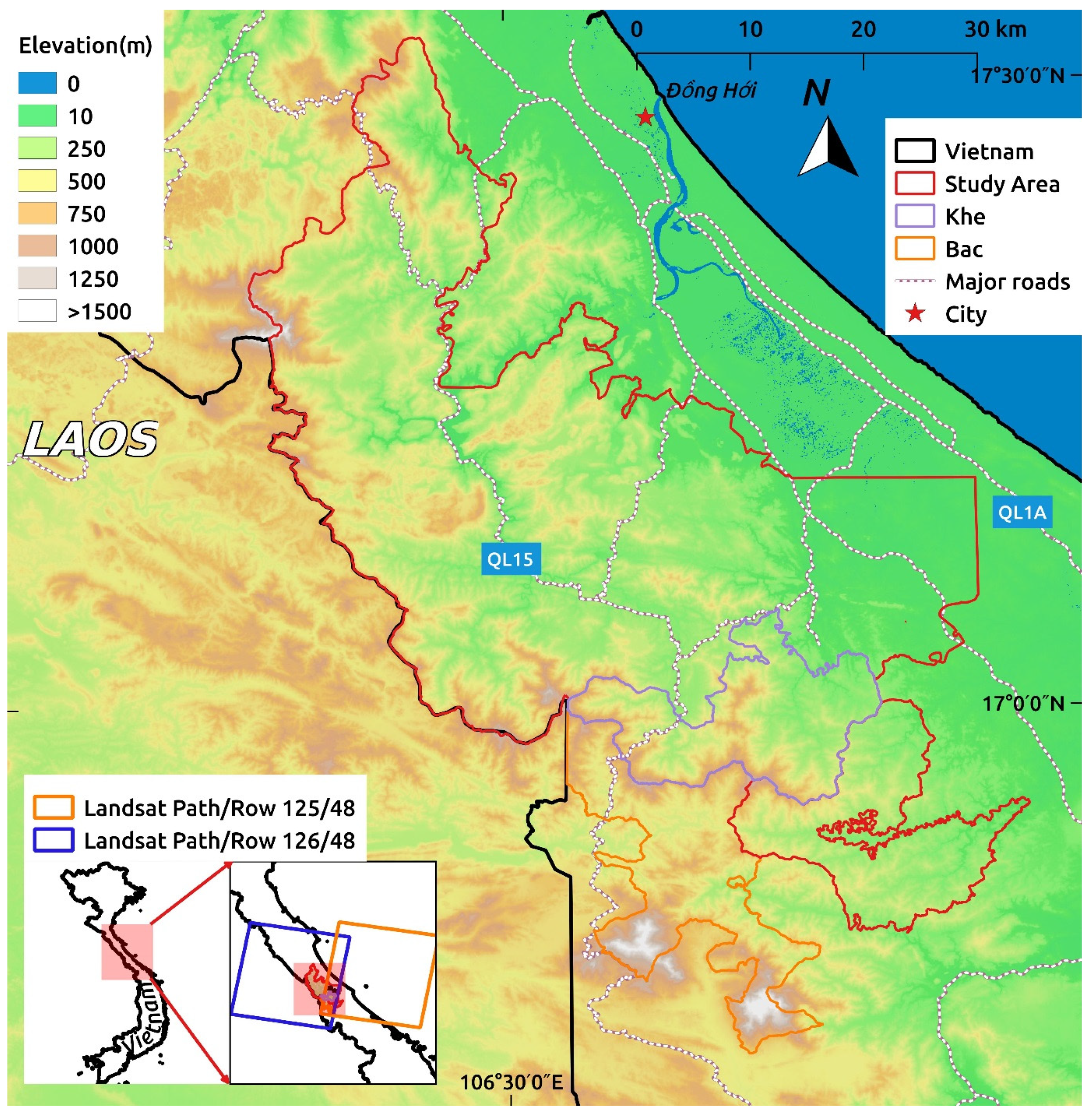
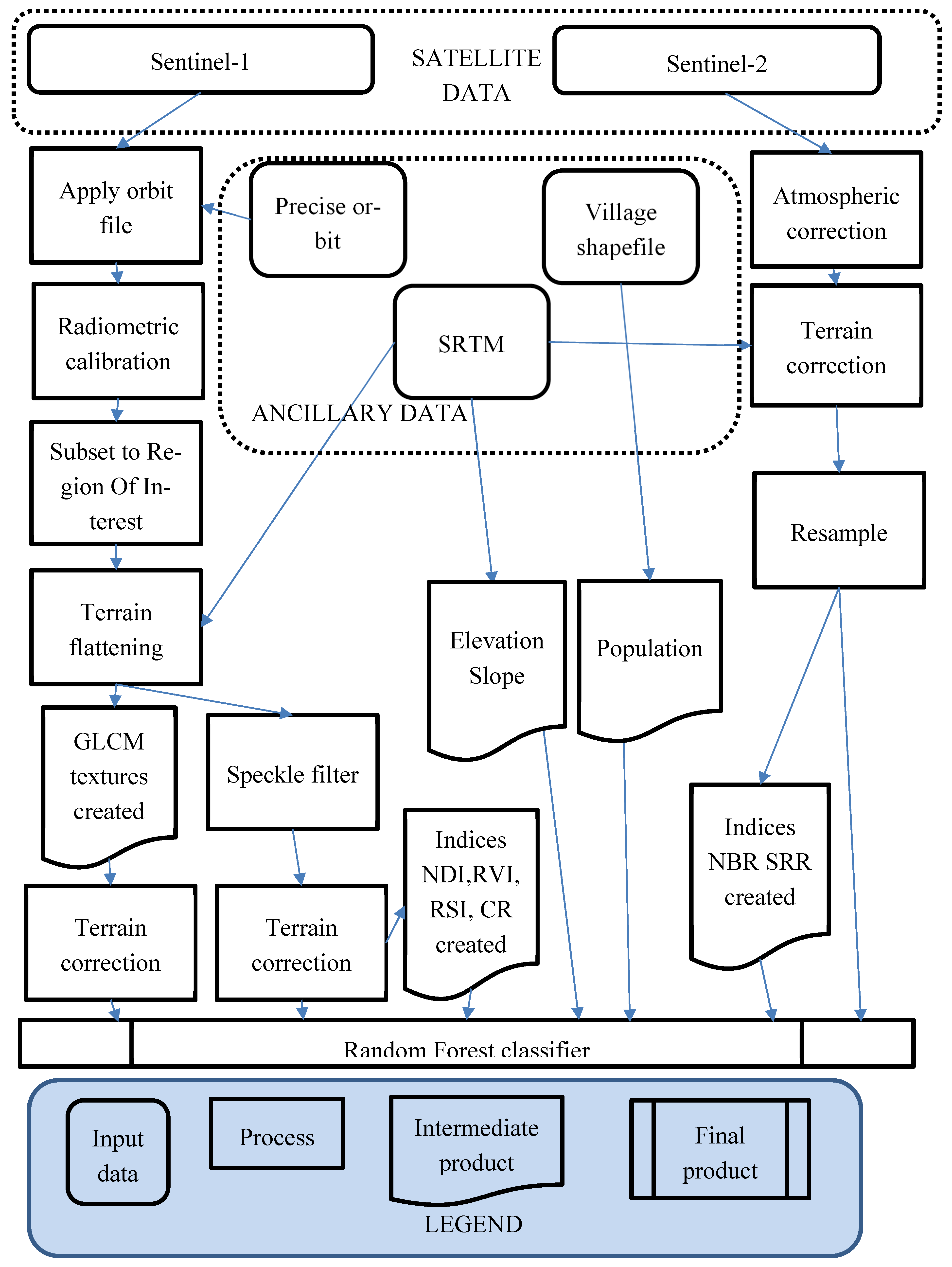
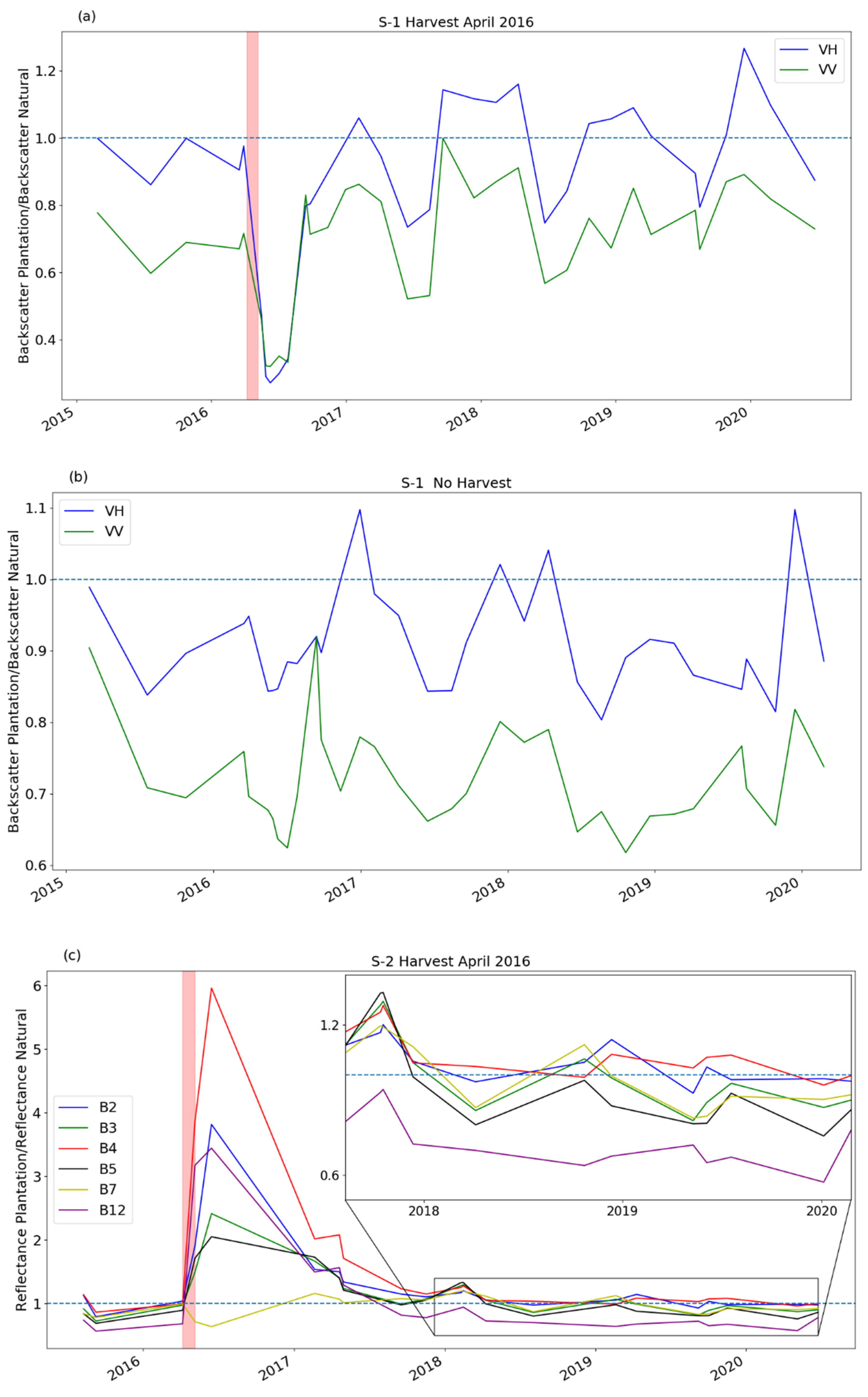
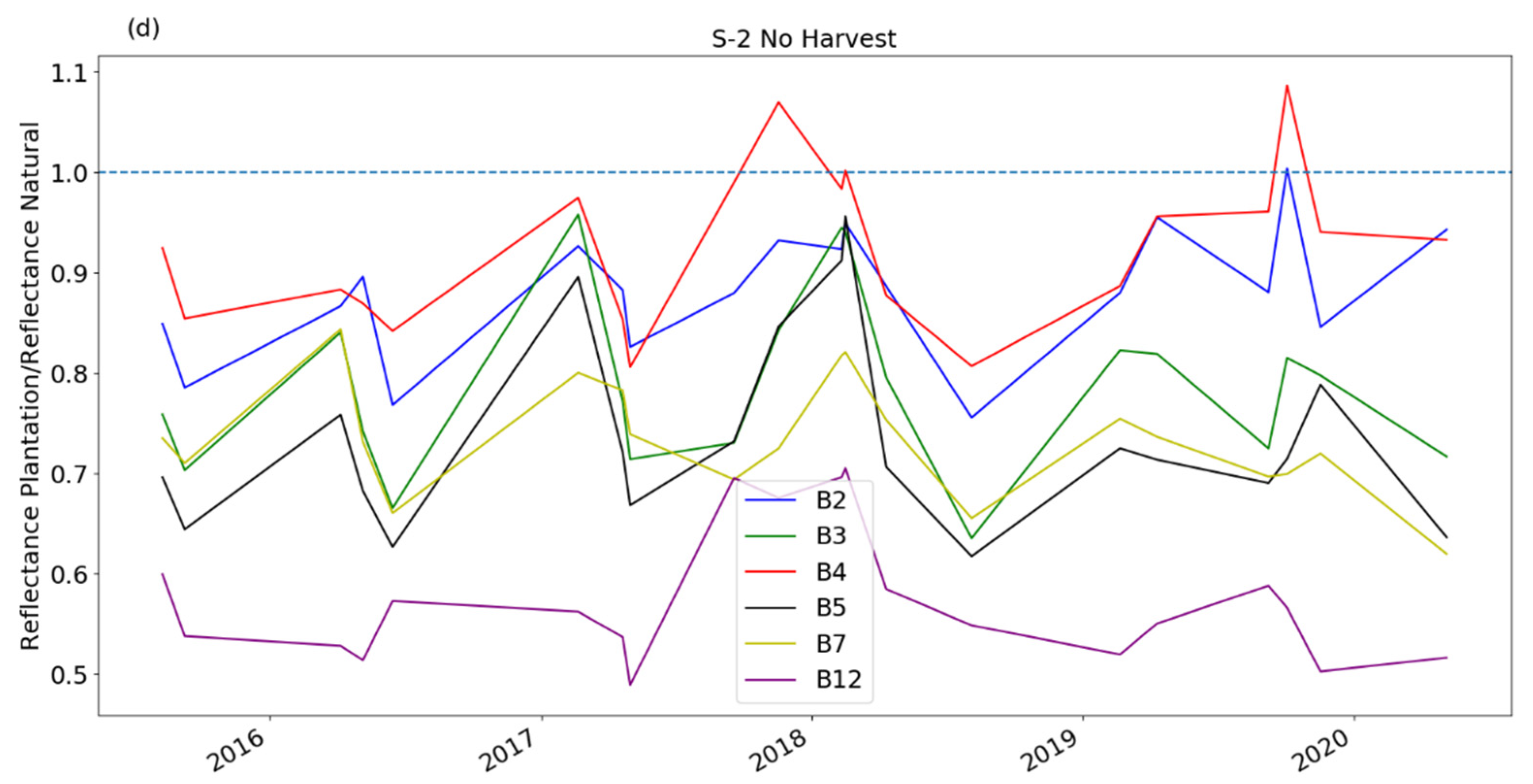
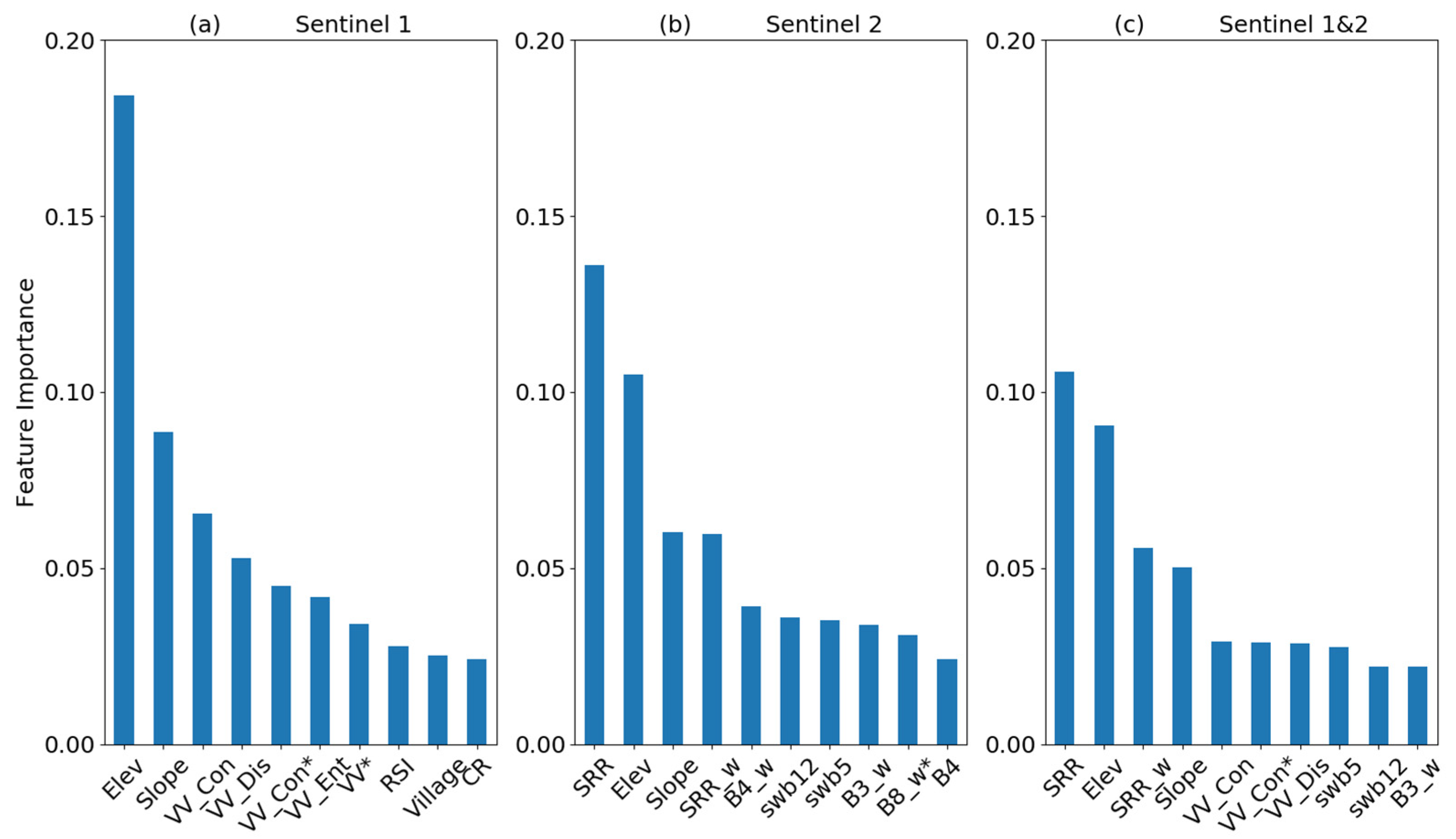
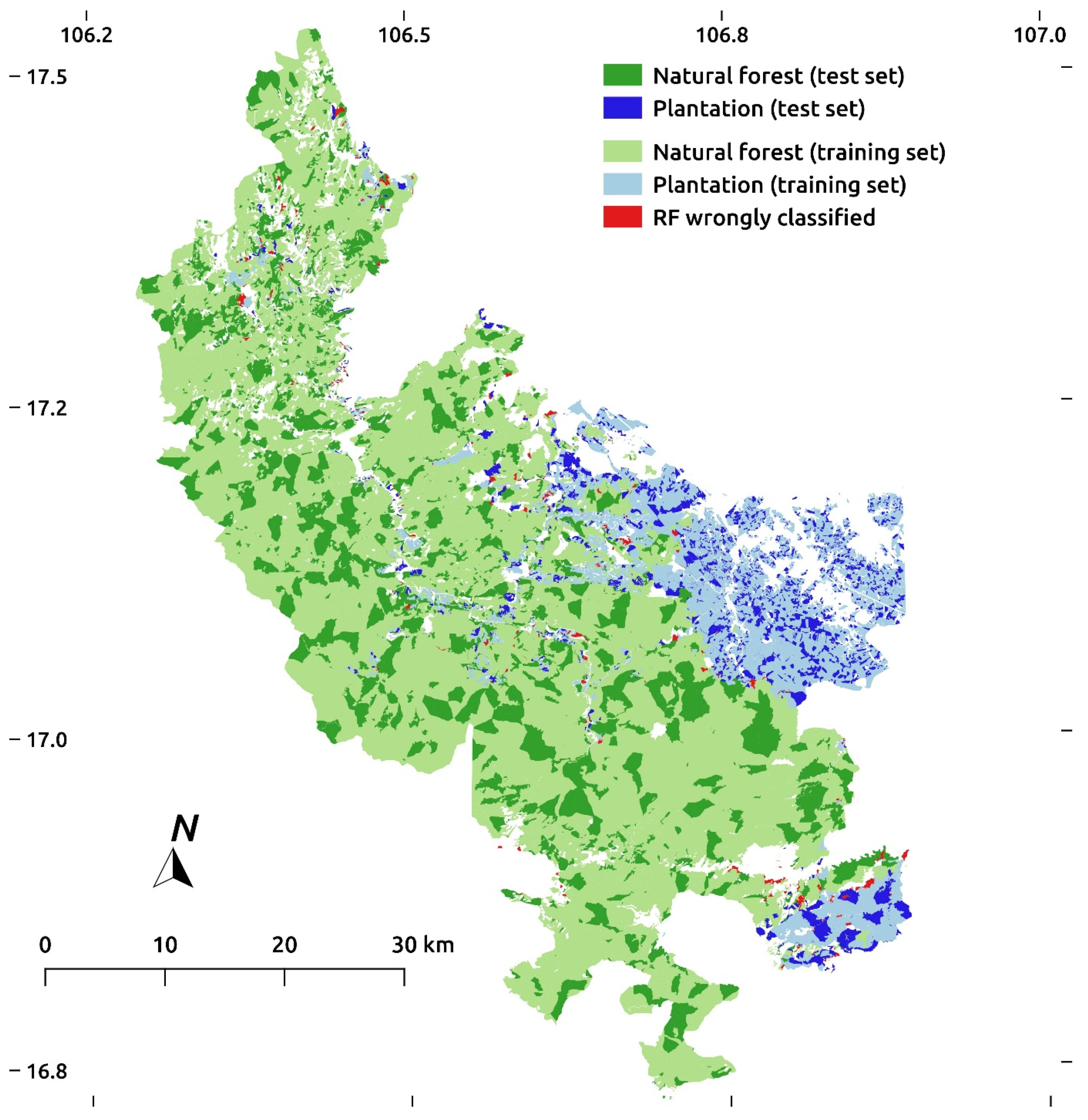
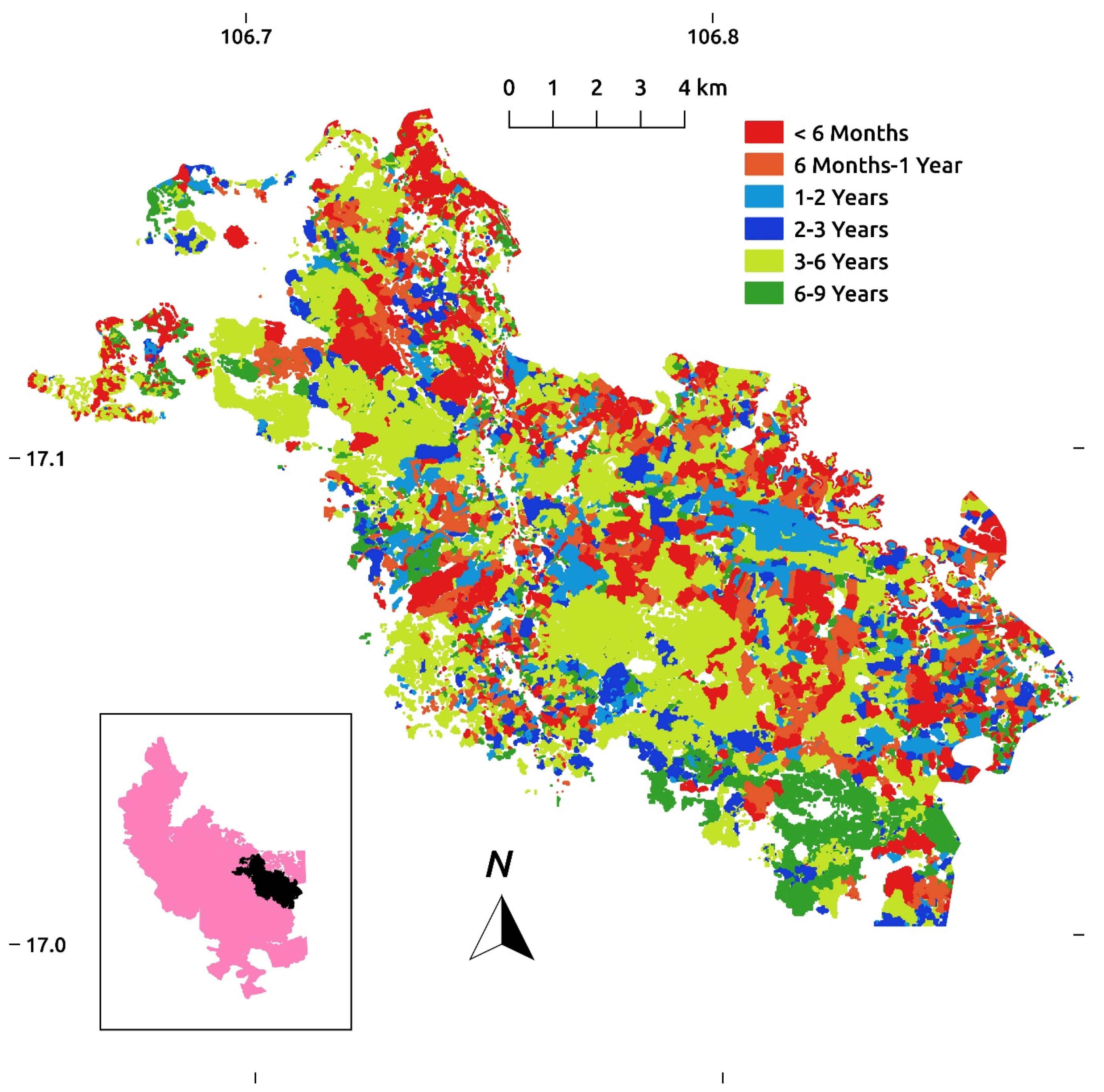
| (a) S-1 Confusion Matrix | |||||
| PREDICTED | ACTUAL | ||||
| Classification | Natural | Plantation | Total | User’s (%) | |
| Natural | 2061 | 391 | 2452 | 84.1 | |
| Plantation | 287 | 2567 | 2854 | 89.9 | |
| Total | 2348 | 2958 | 5306 | ||
| Producer’s (%) | 87.8 | 86.8 | |||
| Overall accuracy (%) | 87.2 | ||||
| (b) S-2 Confusion Matrix | |||||
| PREDICTED | ACTUAL | ||||
| Classification | Natural | Plantation | Total | User’s (%) | |
| Natural | 2134 | 183 | 2317 | 92.1 | |
| Plantation | 214 | 2775 | 2989 | 92.8 | |
| Total | 2348 | 2958 | 5306 | ||
| Producer’s (%) | 90.9 | 93.8 | |||
| Overall accuracy (%) | 92.5 | ||||
| (c) S-1+S-2 Confusion Matrix | |||||
| PREDICTED | ACTUAL | ||||
| Classification | Natural | Plantation | Total | User’s (%) | |
| Natural | 2130 | 190 | 2320 | 91.8 | |
| Plantation | 218 | 2768 | 2986 | 92.7 | |
| Total | 2348 | 2958 | 5306 | ||
| Producer’s (%) | 90.7 | 93.6 | |||
| Overall accuracy (%) | 92.3 | ||||
| S-2 Confusion Matrix | |||||||||
|---|---|---|---|---|---|---|---|---|---|
| PREDICTED | ACTUAL | ||||||||
| Classification | <6 Mon. | 6 Mon.–1 Yr | 1–2 Yr | 2–3 Yr | 3–5 Yr | 5–9 Yr | Total | User’s (%) | |
| <6 Mon. | 109 | 6 | 115 | 94.8 | |||||
| 6 Mon.–1 Yr. | 15 | 85 | 9 | 109 | 78.0 | ||||
| 1–2 Yr. | 5 | 50 | 10 | 2 | 67 | 74.6 | |||
| 2–3 Yr. | 8 | 43 | 20 | 12 | 83 | 51.8 | |||
| 3–5 Yr. | 5 | 40 | 141 | 56 | 242 | 58.3 | |||
| 5–9 Yr. | 6 | 25 | 81 | 112 | 72.3 | ||||
| Total | 124 | 96 | 72 | 99 | 188 | 149 | 728 | ||
| Producer’s (%) | 87.9 | 88.5 | 69.4 | 43.4 | 75.0 | 54.4 | |||
| Overall accuracy (%) | 69.9 | ||||||||
Publisher’s Note: MDPI stays neutral with regard to jurisdictional claims in published maps and institutional affiliations. |
© 2021 by the authors. Licensee MDPI, Basel, Switzerland. This article is an open access article distributed under the terms and conditions of the Creative Commons Attribution (CC BY) license (http://creativecommons.org/licenses/by/4.0/).
Share and Cite
Spracklen, B.; Spracklen, D.V. Synergistic Use of Sentinel-1 and Sentinel-2 to Map Natural Forest and Acacia Plantation and Stand Ages in North-Central Vietnam. Remote Sens. 2021, 13, 185. https://doi.org/10.3390/rs13020185
Spracklen B, Spracklen DV. Synergistic Use of Sentinel-1 and Sentinel-2 to Map Natural Forest and Acacia Plantation and Stand Ages in North-Central Vietnam. Remote Sensing. 2021; 13(2):185. https://doi.org/10.3390/rs13020185
Chicago/Turabian StyleSpracklen, Ben, and Dominick V. Spracklen. 2021. "Synergistic Use of Sentinel-1 and Sentinel-2 to Map Natural Forest and Acacia Plantation and Stand Ages in North-Central Vietnam" Remote Sensing 13, no. 2: 185. https://doi.org/10.3390/rs13020185
APA StyleSpracklen, B., & Spracklen, D. V. (2021). Synergistic Use of Sentinel-1 and Sentinel-2 to Map Natural Forest and Acacia Plantation and Stand Ages in North-Central Vietnam. Remote Sensing, 13(2), 185. https://doi.org/10.3390/rs13020185



